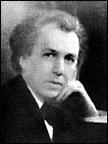Frank Lloyd Wright
 No single individual transformed 20th-century residential architecture more than Frank Lloyd Wright (1867-1959), undoubtedly America's most famous architect. A native of Wisconsin, Wright had little formal architectural training before coming to Chicago at the age of 20, where he secured employment as a draftsman in the architectural office of Joseph Lyman Silsbee and, soon after, with Adler & Sullivan. Under the guidance of Louis H. Sullivan, Wright learned to approach the practice of architecture as a creative abstraction of a structure's function, environment, and technology, rather than relying upon accepted conventions and historical precedents.
No single individual transformed 20th-century residential architecture more than Frank Lloyd Wright (1867-1959), undoubtedly America's most famous architect. A native of Wisconsin, Wright had little formal architectural training before coming to Chicago at the age of 20, where he secured employment as a draftsman in the architectural office of Joseph Lyman Silsbee and, soon after, with Adler & Sullivan. Under the guidance of Louis H. Sullivan, Wright learned to approach the practice of architecture as a creative abstraction of a structure's function, environment, and technology, rather than relying upon accepted conventions and historical precedents.
Wright established his own office in 1893, soon operating out of his home and studio in the suburb of Oak Park. Many of his employees, including Barry Byrne (Immaculata School), William Drummond, Walter Burley Griffin (Griffin Place District), and Marion Mahoney, also went on to significant architectural careers. Wright's early 20th-century residential designs, popularly referred to as "Prairie Style," represent an approach to architecture that defies stylistic categorization. At a time when typical American homes were planned as box-like shells with a honeycomb of individual rooms, Wright's houses embodied a flowing, human-scaled complexity that reflected ideal living conditions rather than rigid enclosures.
Such Prairie-style buildings as the Coonley House (1908) in Riverside, IL, and the Robie House (1909) are monuments in the history of architecture. His experiments in the field of affordable housing (Waller Apartments, American System-Built Houses, and Usonian houses) were particularly innovative. More than 300 Wright-designed buildings were constructed; over 100 are in the Chicago metropolitan area alone.
Among his later, well-known buildings are: the Imperial Hotel in Tokyo, Japan (1922; demolished), Fallingwater (1935) outside Pittsburgh, Pa., Johnson Wax (1936) in Racine, Wis., and New York's Guggenheim Museum (1959). So great is his fame that, following his death, he was honored with his own U.S. postage stamp, as well as a song, "So Long, Frank Lloyd Wright," written by the popular musical duo, Simon and Garfunkel.